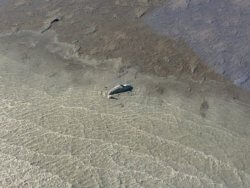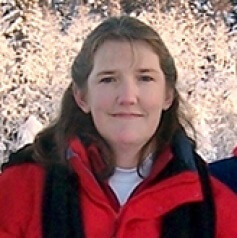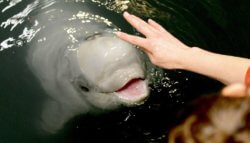Tyonek was spotted from the air lying almost dead on a deserted beach in Alaska. And everyone who has been involved in his round-the-clock care at a rehab center for the last five months has done a sterling job.
Yet the future of this baby beluga is bleak.

Tyonek on the beach. Photo by NOAA
The story began last fall when Noah Meisenheimer, an enforcement officer of the National Oceanic and Atmospheric Administration (NOAA)’s National Marine Fisheries Service (NMFS), was being helicoptered back to Anchorage from his work investigating the death of a beluga. Flying up the west coast of Cook Inlet, he spotted a gray shape on the beach and asked the pilot, Kenneth Reiser, to turn around and land close by.
On the sand, they identified the gray shape as a baby beluga, about a month old, five feet long, barely alive, his skin dried out by the sun.
Belugas in that region are endangered, so Meisenheimer called NMFS’s Office of Protected Resources and got permission to move the animal into deeper water. But despite their several attempts, the exhausted calf simply turned back toward shore.
Meisenheimer called Dr. Carrie Goertz, the Alaska SeaLife Center’s director for animal health, who hastened to the scene.
Beluga calves normally stay with their mothers for at least two years, but there were no signs of any other belugas in the water nearby. And the baby was still resisting any effort to return him to the ocean.

Dr. Carrie Goertz
“I felt that he had zero chance of survival in Cook Inlet,” Dr. Goertz later told the Anchorage Daily News. “And I felt that at least initiating the attempt of a rescue, that that wasn’t going to be cruel and unusual.”
Time was of the essence in saving the baby’s life. So, they took one of the passenger seats out, and using a body bag as a makeshift sling, eased the baby into the back of the Helo3, with the veterinarian sitting at his side.
Meanwhile, emergency staff from SeaLife, the only marine mammal rehabilitation facility in Alaska, were on their way to the helicopter pad in Anchorage with their “cetacean wagon,” a large pickup truck loaded with emergency supplies.
Next day, experts from the Georgia Aquarium in Atlanta, the Mystic Aquarium in Connecticut, various SeaWorld facilities, the Shedd Aquarium in Chicago and the Vancouver Aquarium all converged on SeaLife to join the 24/7 effort to restore the baby’s health and wellbeing.
At first, the youngster couldn’t even support himself in the water, and it took four people to feed and hydrate him. Within a few days, however, he was growing stronger, but it was still touch-and-go for the first few weeks as he struggled with intestinal problems, skin problems and other issues.
They named the calf Tyonek, which means “little chief” in the local language of the village near where he was found. And over the next month, he gained 39 pounds on his baby formula of powdered milk substitute supplemented with salmon oil and herring filets pureed in a Vitamix blender – two pints at a time, six times a day.
The beluga population in the Cook Inlet has shrunk from about 1,300 in 1979 to an estimated 328 today, and NOAA wanted to give the youngster every chance to rejoin others of his kind. So, while looking after Tyonek, Dr. Goertz and the team were being careful to steer a course between giving him the kind of contact baby belugas normally get from their mothers, aunts and sisters, and not letting him become so conditioned to humans that it would be difficult for him to be released back to the wild.
One example of the environmental enrichment program was to play beluga sounds from Cook Inlet whales, twice a day in five-minute intervals. Tyonek listened carefully and was learning to mimic the calls he was hearing.

Tyonek has gained 60 pounds since he was rescued in late September, 2017.
All the same, everyone knew that release was a long shot. Growing up in the ocean, Tyonek would have been learning so much more from his mother and all his extended family: survival skills, communication skills, social skills. Still, the plan was to keep every option open, and the baby beluga seemed to bond with his caregivers, chatting away with chirps and clicks.
“He’s very tactile,” Goertz told the Washington Post in an interview. “Typically a beluga calf is touching his mom most of the time . . . He’s definitely looking for that type of interaction.”
Tyonek would certainly be a candidate for transfer to a future seaside sanctuary.
Ultimately, on February 8th, 2018, NOAA concluded that Tyonek couldn’t be released back to the Cook Inlet because he was too young when found and lacks the skills he would need to survive on his own. Instead, the now-five-month-old whale would need to spend the rest of his life in human care.
And so began the process of deciding where he should go. This involved checking out the various aquariums and marine theme parks in North America that have belugas.
There should, of course, be one other option: a seaside sanctuary. But while there are numerous sanctuaries in the United States for land-based animals of almost any kind, from elephants to big cats to great apes to birds and butterflies, there are none yet for whales and dolphins.
NOAA has now concluded that the best place for Tyonek is SeaWorld San Antonio, which at least has adult females and other male calves with whom the calf will be able to socialize. A date for his transfer has yet to be announced.
NOAA hopes to learn more from Tyonek while he grows up at SeaWorld. They write:
“By monitoring Tyonek as he grows from a calf to an adult animal, we can learn important information about his physical and behavioral development, including his hearing, vocalizations, social interactions, and overall body condition.
“This knowledge will help inform the protection and recovery of wild populations of belugas, specifically Cook Inlet beluga whales, which are one of eight endangered species that NOAA Fisheries identified as [being] most at risk of extinction.”
The downside, of course, is that Tyonek will be spending his entire life in a concrete tank, earning his keep by performing for human audiences.
There’s still a chance, of course, for the young beluga, since he would certainly be a candidate for transfer to a future seaside sanctuary.
The people who came to look after him from aquariums and marine theme parks across the U.S. and Canada have already given Tyonek back his life. What he needs now is a life where he can grow and thrive – along with others of his kind who may also be retired from the entertainment industry – in an environment that’s as close as possible to the life he would have known in the ocean where he was born.
Working together, we could make that happen.
21 Comments
Will you be able to retrieve it frim seaworld once the sanctuary is built ? Who will have , per say, “ownership” of the baby ?
When a marine mammal is deemed by NOAA to be unreleasable, and the agency chooses a facility to house the animal permanently, s/he becomes the facility’s “property.” So, it would be for SeaWorld to agree to any of “their” animals to a seaside sanctuary.
How can we- people who are reading this page, people who are using the internet- people who have social media, help the cause? I feel that that its such an amazing cause, and so want to be part of it in whatever way I can.
Are there flyers to be sent out? I hate the idea of that poor beluga baby going to SeaWorld, I just think its horrible that the only current solution is to send him there- BUT – I understand there isnt seeminly anywhere else that could take him properly, SO thats why this sea sanctuary needs to happen- why so MANY sea sanctuaries need to be founded .
Here in the UK we have a seal sanctuary called GWEEK and they do an amazing jobs rescuing seals and sea birds that get affected/abandoned etc. Government and public funded they do well. Im sure that people would willingly help out if more people knew that the sea pens were trying to be built.
Keiko once had one in Norway did he not? I followed his case with huge interest.
The one whale I am the most sad about is Lolita. Thats such a Bullsht environment for her. They’re all in horrible places, but hers is just ridiculous. And heartbreaking.
So. Let us know, tell us how we can help and spread the word, and cause a famous twitter uprising!
I suggest you check your history books as I just watched a documentary about a baby beluga released back to the wild in eastern Canada. They found some male adults and they stayed with the babe until a female came and the babe swam away with her. So I don’t believe you. I think if you found a pod and released him with them he could have a very good chance of survival.
I believe you’re talking about the documentary called “Call of the Baby Beluga” in the Canadian series The Nature of Things. I haven’t seen it personally since it’s only available online to viewers in Canada. But from what I understand of it, there are some significant differences in the two cases. The calf in the St. Lawrence was taken off the beach by the researchers and immediately brought to a location in the estuary near other whales. In the case of Tyonek, there were no whales observed in the vicinity. The scientists in the Canadian situation knew there were huge risks to putting the little calf back out there, but her chances were at least better than when she was stranded on the shore.
By the end of the documentary, the researchers knew only that a group of males stayed with the baby for about an hour then left her on her own. After about another hour, a female with a calf came and interacted with the orphan and the three dove together and were not seen again. The researchers had taken a small skin sample for DNA and hope perhaps in the future they will find a match. As of yet, everyone holds onto hope rather than proof that the little one has survived.
It’s always difficult to know what’s best in any of these cases. In many other countries, it’s considered best to euthanize baby whales who are found beached. That was not the call that NOAA made in Tyonek’s case. But in saving her life, they knew from the start that it was likely they would not be able to return her to the ocean.
Those are the facts as we understand them here. And we look forward to a time when a baby whale like Tyonek will have the possibility of spending her life at a seaside sanctuary rather than a marine entertainment park.
Who benefits? I’m very confident that SeaWorld don’t do this for the sake of a species..I feel sick that this poor Beluga (and so many others) will spend his life in a concrete tank performing for his keep and human entertainment…this is NOT the way to educate people about marine mammals…
Indeed. The ONLY satisfactory solution for any animal who cannot be returned to his/her natural environment is a sanctuary.
Can’t agree more my first reaction when read SeaWorld ughh. Will be glad when these hell holes are shut down for good
Poor little guy !!!! That is quite a “promising” futur that awaits him at SeaWorld !!!! Enslaved for life, exploited for money and overbred for his new genes… yep SeaWorld’s new way to obtain new stock to add to their limited genepool – just call it rescue and rehab ugghh…..
ffff…. poor little one !!!! enslaved for life at SeaWorld to be exploited and to die prematurely… as they ALL do – quite a happy life that awaits him no ???
SeaWorld!? The biggest abusers… Noooo! If this is to be, it should be with the stipulation that once the sanctuary is ready, he will be transferred there!
Yes!
It’s great his life was dmsaved but a life of captivity omusnt much of a life but at least he is alive maybe someone will come through for him to live in s sanctuary. Good luck to Tyonek. He’s beautiful!
What is the hold up for sea sanctuary’s?
There’s no hold-up, Sara. It’s the mission of the Whale Sanctuary Project to create the first seaside sanctuary in North America for captive orcas and belugas. (Check out the “Our Work” page on this website for more info.) Thanks for asking!
This is sad! No option but SeaWorld. A life of slavery? At least try him in the ocean under observation. If it were me I would be wishing you had left me on that beach!!!!! SeaWorld? OMG! WTH are you thinking!!!!!
You would prefer it had died on the beach? Sick. Seek help.
Quality of life always trumps quantity and/or death.
Sea World is not the most humane, or ethical choice.
Perhaps you would prefer to live a long life on life support, or in captivity making money for your captors .
You need to think out of your little box of a brain, and look at ALL
Sides of a picture before passing judgment on us “sick”(??) people.
Can’t agree more my first reaction when read SeaWorld ughh. Will be glad when these hell holes are shut down for good
Soooo sad, why not try and find family in the waters where he was found. Why Sea World ?
They did look in waters nearby, as is required. But found no families in the vicinity. Further afield , it would be hard to know if a family they spotted was the right one and if they would accept the baby. It’s also likely that the mother had either already died or had, for whatever reason, abandoned her calf … and would do the same again. NOAA has strict (and reasonable) policies about all this, and they were followed to the letter.